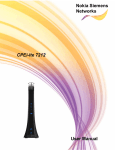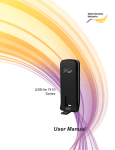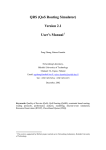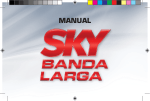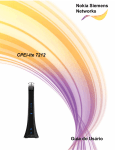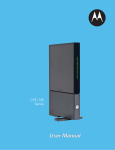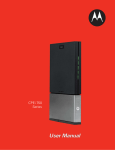Download Motorola CPEi 800 Series User manual
Transcript
CPEi 800/825 Series User Manual * Please see the Introduction Section Contents Introduction ..............................................................................................................................iii Chapter 1: CPEi 800/825 User Guide Overview .......................................................................................................................................... 1-1 Powerful Features in a Single Unit .................................................................................................. 1-2 Front of the CPE .............................................................................................................................. 1-2 Back of the CPE ............................................................................................................................... 1-3 Operating Information ..................................................................................................................... 1-3 Chapter 2: Installation Overview .......................................................................................................................................... 2-1 Before you Begin.............................................................................................................................. 2-1 Easy Setup ....................................................................................................................................... 2-1 Advanced Setup ............................................................................................................................... 2-2 Procedure to Log into the CPE ........................................................................................................ 2-2 Setup Wizard and Authentication .................................................................................................... 2-3 Restart Button.................................................................................................................................. 2-5 Chapter 3: Basic Configuration Before you Begin.............................................................................................................................. 3-1 Personalize Menu............................................................................................................................. 3-1 Password Tab ................................................................................................................................... 3-2 Device Time Tab .............................................................................................................................. 3-2 Device Name Tab ............................................................................................................................. 3-2 Restore Factory Settings Tab........................................................................................................... 3-3 Internet Menu .................................................................................................................................. 3-3 WiMAX Security Tab ........................................................................................................................ 3-4 Internet Protocol Tab ....................................................................................................................... 3-4 Firewall Tab ..................................................................................................................................... 3-4 Dynamic DNS Tab ............................................................................................................................ 3-5 Status Menu..................................................................................................................................... 3-5 Network Tab .................................................................................................................................... 3-6 Telephony Tab (CPEi 825 Models only) ........................................................................................... 3-6 Telephony Menu (CPEi 825 Models only) ........................................................................................ 3-6 Account Tab ..................................................................................................................................... 3-7 AUG 2011 i Ring Tone Tab .................................................................................................................................. 3-8 Caller ID Tab.................................................................................................................................... 3-8 Call Forwarding Tab ........................................................................................................................ 3-8 Voice Mail Tab ................................................................................................................................. 3-9 Special Number Tab ........................................................................................................................ 3-9 Chapter 4: Advanced Configuration Port Forwarding Menu..................................................................................................................... 4-1 Forwarding Tab ............................................................................................................................... 4-2 Local Address Menu......................................................................................................................... 4-2 DHCP Server Tab............................................................................................................................. 4-3 Lease Status Tab.............................................................................................................................. 4-4 Lease Reservation Tab ..................................................................................................................... 4-4 Control Panel ................................................................................................................................... 4-5 Software Tab.................................................................................................................................... 4-6 Certificate Tab ................................................................................................................................. 4-6 System Tab ...................................................................................................................................... 4-6 About Tab......................................................................................................................................... 4-6 Chapter 5: Configuring TCP/IP Configuring TCP/IP in Windows 2000.............................................................................................. 5-1 Configuring TCP/IP in Windows XP ................................................................................................. 5-5 Chapter6: Troubleshooting Power ............................................................................................................................................... 6-1 A Computer Cannot Log On to the CPE ........................................................................................... 6-1 Cannot Connect to the Internet ....................................................................................................... 6-1 Additional Troubleshooting Help ..................................................................................................... 6-1 Chapter 7: Important Safety and Legal Information ........................................ 7-1 ii AUG 2011 Introduction Introduction This User Manual is for the Nokia Siemens Networks CPEi 800 and CPEi 825 models of desktop modems. The specific model numbers and additional details are included in the table below. Table i-1 Desktop Modem Models - Data Only Data Only Models CPEi 23800 CPEi 25800 CPEi 35800 Table i-2 Desktop Modem Models - Data Plus VoIP Data Plus VoIP (Voice over Internet Protocol) Models CPEi 23825 CPEi 25825 CPEi 35825 Throughout this manual, references made to VoIP are applicable only to the CPEi 825 series of products. The CPEi 800 series of products do not include the RJ-11 telephone connector on the back of the device, the telephony LED or any reference to telephony in the Graphical User Interface (GUI). AUG 2011 iii CPEi 800/825 User Guide 1 Chapter 1: CPEi 800/825 User Guide Overview Thank you for purchasing the Nokia Siemens Networks CPE Indoor CPEi 800/825 desktop device. The Desktop CPEi 800/825 allows you to connect to the wireless world easily and seamlessly without complicated installation and setup procedures. In addition, it offers you the ability to make Voice over Internet Protocol (VoIP) calls. The Desktop CPE indoor CPEi 800/825 device provides the user: Convenience - with easy plug and play functionality. Compact design. Control - remote management capability allows easy detection and authentication when the unit is set up. VoIP - RJ11 port allows for Voice over IP calls using your CPEi 825. The features and the physical appearance of your Desktop CPEi 800/825 device may differ slightly from the illustration. Figure 1-1: CPEi 800/825 CPEi 800 CPEi 825 For the most recent documentation, visit the Product Documentation page on www.nokiasiemensnetworks.com/devices. AUG 2011 1-1 1 CPEi 800/825 User Guide Powerful Features in a Single Unit The CPE device provides the following features: WiMAX Authentication WAN DHCP Client LAN DHCP Server Home Gateway Functions Firewall Protection Port Forwarding Front of the CPE The front of the CPE unit contains LED Link/Activity indicators. The LEDs show the status of the unit and signal strength indicators for easy adjustment during setup. Table 1-1 LED Indicator Interface LED Status Signal Strength Full WiMAX Signal Strength is detected when all WiMAX Signal Strength LEDs are lit. WAN WiMAX All WiMAX Signal Strength LEDs are off - very low signal detected. One to two WiMAX Signal Strength LEDs are lit - low signal detected. Three to five WiMAX Signal Strength LEDs are lit - high signal detected. While acquiring access to the WiMAX Network: All WiMAX Signal Strength LEDs vary between ON, OFF and/or BLINKING status. If all five WiMAX Signal Strength LEDs are blinking, then a software upgrade is in progress. Do NOT remove power to the CPE. 1-2 AUG 2011 CPEi 800/825 User Guide 1 Back of the CPE The back of the CPE unit contains the RESET switch, DC Power Connector, Ethernet connector (RJ-45), Ethernet LED and ATA port (RJ-11). Figure 1-2: CPE Ports and Connections CPEi 800 CPEi 825 Table 1-2 Port Descriptions Port Description Ethernet Ethernet Port. Power DC Power Connector. Reset Hardware Reset Button (A paperclip is recommended for accessing this button). Phone Line RJ-11 port for use with VoIP. Operating Information Operating temperature for this unit is 0-40°C (32-104°F). AUG 2011 1-3 Installation 2 Chapter 2: Installation Overview To install the Desktop CPEi 800/825 Series, review the following sections: Before You Begin Easy Setup Before you Begin Before you begin installation, check that you have received the following items with your Desktop CPEi 800/825: Table 2-1 In the box with your CPE, you should have Item Description AC Power Adapter Power adapter cord connects the Desktop CPE to an AC electrical outlet. Ethernet Cable The Ethernet cable connects the Internet port on your Desktop CPE to your PC or laptop computer. Desktop CPEi 800/825 Quick Start Guide Desktop CPEi 800/825 Quick Start Guide. Desktop CPEi 800/825 Regulatory Guide Desktop CPEi 800/825 Regulatory Guide. In addition, you need: A computer An RJ-11 telephone cable (if applicable) Easy Setup The CPE is easily set up in your home. Basic installation equipment needed are the power adapter and cord, Ethernet cable, a PC or laptop computer and the CPE device. If you want to use the VoIP functionality, you need an RJ-11 phone cable and a telephone. Perform the following tasks before attaching the power cord or powering up the unit: Stand the CPE on a flat surface. Plug the power adapter into the power connector on the back of the unit. Plug the AC power cord into an AC outlet. Plug one end of the Ethernet cable into the Ethernet connector on the back of the unit. Plug the other end of the Ethernet cable into the Ethernet connector of your computer. To use VoIP functionality of the phone, plug one end of the phone line into the activated phone connector on the back of the unit. Phone line activation is dependent upon your service contract. Plug the other end of the phone line into the phone line connector of your telephone. AUG 2011 2-1 2 Installation Advanced Setup The CPE can also be used to connect to a multi-port switch (hub) – purchased separately from the CPE. Connecting the CPE device to a hub allows you to connect more than one computer to your CPE device. Procedure to Log into the CPE Before you Begin Configuration Some settings on your computer need to be verified or changed to ensure that your computer configuration can support the Desktop CPE. Verify that the IP addresses and DNS settings are automatically generated in the Local Area connection of your Internet Protocol (TCP/IP) properties. Refer to the chapter titled “Configuring TCP/IP” for additional information. Logging in to the CPE Use the following procedure to log into the Desktop CPE: 1. 2. On a computer that is connected to the Desktop CPE, open a web browser. In the Address or Location field, type http://mywimax. and press ENTER to display the login screen. Include the period (.) after http://mywimax. in order to access the login screen. Alternatively, you may enter the IP address: http://192.168.15.1 into the Address field in order to gain access to your CPE. If you cannot access the CPE, refer to the chapter titled: Configuring TCP/IP for more information. 3. The Welcome to Nokia Siemens Networks WiMAX CPE screen is displayed and prompts you for a password. 2-2 AUG 2011 Installation 2 Figure 2-1: Login Screen 4. 5. 6. 7. In the password field, type the password (default is nsn). Click Login. First time users see a pop-up box that states: “The Wizard application will guide you through for the first time configuration”. Click OK to continue. Click the OK to launch the wizard application. In some earlier versions of software, the default password is motorola. Setup Wizard and Authentication Step 1 - Change Password After you have launched the setup wizard, you are prompted to change your password. Nokia Siemens Networks recommends using a password to protect your home network and CPE device. Passwords are case sensitive. To change your password: Ensure the “Enable Login Password Protection” box is checked. Enter a New Login Password in the box. Passwords can be no more than 20 characters in length. Re-type your new password in the Confirm New Login Password box. Click Next. If you forget your password, you can reset it back to the default (nsn) password. To reset the password, press and hold the reset button on the back of your CPE for 7 or more seconds. Before resetting the CPE, ensure that the power is ON. AUG 2011 2-3 2 Installation In some earlier versions of software, the default password is motorola. Step 2 - Device Time This screen allows you to set the time zone and to enable Daylight Savings Time (when applicable) for your location. Select the appropriate time zone for your location from the drop-down box. Check “Auto Adjust for Daylight Savings Time” if you live in a region that observes Daylight Savings Time. This box is checked by default. Click Next. Step 3 - WiMAX Security The WiMAX Security tab contains your authentication method. Check with your service provider to determine if they require a user name and password for authentication purposes. If the Authentication Method is EAP-TLS, a User Name and Password is not required. Enter the Realm information supplied by your service provider. Click Next. If the Authentication Method is EAP-TTLS/MS-CHAPv2, enter User Name and Password, and Realm information supplied by your Service Provider. When you have entered the User Name/Password/Realm information, click Next. If you are unsure of the Authentication Method, select EAP-TLS (which is the default) and click Next. Step 4 – Account The Account tab allows you to manage Voice over IP (VoIP) related services. Please consult with your telephony service provider for these settings. Click Apply when finished. Congratulations! You have now completed the setup of your WiMAX connection. Click OK on the Congratulations! dialog box. A status screen appears that shows Network status and telephony status. The Network Status screen provides any status associated with your WiMAX Wireless Broadband connection. The Telephony Status screen provides status of your telephony service. Restart is used to restart the device. The restart button is available on every screen. Wizard starts the set-up wizard over again. Refresh refreshes the screen with the current status. Auto Refresh allows the web browser to automatically refresh at the interval determined in the Control Panel menu. 2-4 AUG 2011 Installation 2 Figure 2-2: Status Screen Restart Button Figure 2-3: Restart Button Restart Wizard Refresh Auto Refresh AUG 2011 2-5 Basic Configuration 3 Chapter 3: Basic Configuration Before you Begin When the CPE setup has been completed, you can log in to your CPE from any computer on your home network. To log in, type the device name in the address bar on your computer. The default device name is mywimax. This section describes the PERSONALIZE, INTERNET and STATUS Menus that are available. Personalize Menu The Personalize menu provides the following tabs: Password Device Time Device Name Restore Factory Settings Figure 3-1: Personalize Menu To Access the Personalize menu, click the Computer icon, then click Personalize. AUG 2011 3-1 3 Basic Configuration Password Tab The password tab allows you to enable/disable password protection. You can also change your password here. Click Apply when finished. Table 3-1 Password Tab Field or Button Description Enable Login Password Protection Checking this box requires login password protection. New Login Password Enter your new password here. Maximum 20 characters. Passwords are case sensitive. Confirm New Login Password Re-enter your new password here, exactly as entered in the previous step. Device Time Tab The Device Time tab allows you to establish the time zone for your location. It also allows you to automatically adjust for Daylight Savings Time if necessary. Click Apply when finished. Table 3-2 Device Time Tab Field or Button Description Current Local Time Current Local Time Time Zone Select your local time zone from the dropdown box. Auto Adjust for Daylight Saving Time Check this box if your location observes Daylight Savings Time (Default is checked). Device Name Tab The Device Name tab allows you to rename your CPE device. The Device Name is the name you enter on an internet browser address bar to access your CPE device. Click Apply when finished. Table 3-3 Device Name Tab Field or Button Description New Device Name Enter the new name for the CPE device. Maximum 20 characters. 3-2 AUG 2011 Basic Configuration 3 Restore Factory Settings Tab The Restore Factory Settings Tab resets your CPE to the manufacturer default settings. Click Apply if you are sure you want to reset factory settings. Table 3-4 Restore Factory Settings Tab Field or Button Description Restore Factory Settings Checking this box restores the CPE to factory default settings. The device restarts when you click Apply. Internet Menu The Internet menu provides the following tabs: WiMAX Security Internet Protocol Firewall Dynamic DNS Figure 3-2: Internet Menu To access the Internet menu, click the Computer icon, then click Internet. AUG 2011 3-3 3 Basic Configuration WiMAX Security Tab The WiMAX Security tab contains your authentication method. Check with your service provider to determine if user name and password are required for authentication purposes. Table 3-5 WiMAX Security Tab Field or Button Description Authentication Method Drop down box allows you to select either EAP-TLS (default) or EAP-TTLS/MSCHAPv2. User Name (EAP-TTLS/MS-CHAPv2 only) Enter the User Name supplied by your service provider. Password (EAP-TTLS/MS-CHAPv2 only) Enter the Password supplied by your service provider. Realm Supplied by your service provider. If your authentication method is EAP-TLS, a User Name and Password is not required. Click Apply. Internet Protocol Tab Check with your service provider for these settings. If you are unsure of the settings, leave the default values set. Click Apply. If your service provider has instructed you to change any of these settings, click Apply when finished. Firewall Tab A firewall helps to protect your home network from unauthorized access. It also helps to manage authorized access from the internet to your CPE. Table 3-6 Firewall Tab Field or Button Description Enable Firewall Check this box to enable the firewall for your home network. Enable Web Login from Internet (Grayed out if Enable Firewall is not selected). Checking this box enables you to access your CPE device from a network other than your own. Web Login Port from Internet Choose a port number to connect to when logging in from a network other than your own. The default is 8080. Enable ping from Internet Enables the CPE to respond to a ping from the Internet. This option is enabled to allow testing only. Do not leave this enabled. Click Apply when you are finished. 3-4 AUG 2011 Basic Configuration 3 Dynamic DNS Tab Dynamic Domain Name Service (DDNS) allows a user with a non-static IP address to keep their domain name associated with an ever changing IP address. As an example, DDNS is used when you are hosting your own website. Table 3-7 Dynamic DNS Tab Field or Button Description Enable DDNS Check this box to Enable DDNS (default is unchecked). DDNS Service Provider Select DDNS Service Provider that you belong to from the drop-down box. DDNS User Name Only valid if Enable DDNS is checked. Enter your DDNS account user name. DDNS Password Only valid if Enable DDNS is checked. Enter your DDNS account password. DDNS Host Name Only valid if Enable DDNS is checked. Enter the DDNS Host Name. This is assigned by the DDNS service. Click Apply when you are finished. Status Menu The Status menu provides the following tabs: Network Telephony AUG 2011 3-5 3 Basic Configuration Figure 3-3: Status Menu Network Tab The Network tab provides any status associated with your WiMAX Wireless Broadband connection. Telephony Tab (CPEi 825 Models only) The Telephony tab provides any status associated with your telephony connection. Telephony Menu (CPEi 825 Models only) The telephony menu allows you to manage your Voice over Internet Protocol (VoIP) services. Contact your service provider to obtain VoIP service. The Telephony menu provides the following tabs: Account Ring Tone Caller ID 3-6 AUG 2011 Basic Configuration Call Forwarding Voice Mail Special Numbers 3 Figure 3-4: Telephony Menu Account Tab Consult your service provider for these settings. Table 3-8 Account Tab Field or Button Description User Name If Line is an active VoIP, enter the User Name as provided by your service provider. Password Enter the Line password as provided by your service provider. Passwords are case sensitive. Confirm Line Password Re-enter your Line password exactly as entered in the field from the previous step. Click Apply when you are finished. AUG 2011 3-7 3 Basic Configuration Ring Tone Tab The Ring Tone tab allows you to customize ring tones for your telephone(s). You need a phone connected to your CPE to hear ring tones. Table 3-9 Ring Tone Tab Field or Button Description Default Line Ring Type Use the drop-down box to select a ring tone for Line. The default is ring tone R0. Test Click to hear how the selected ring tone sounds. Click Apply when you are finished. Caller ID Tab The Caller ID tab allows you to manage the Caller ID functions for your telephone(s). Table 3-10 Caller ID Tab Field or Button Description Enable Line Anonymous Incoming Call Rejection If Line is your active telephone port, check this box to reject telephone calls from anonymous incoming callers. The default is checked. Enable Line Permanent Anonymous Outgoing Call If Line is your active telephone port, check this box to permanently block your telephone number from appearing on others’ Caller ID. The default is unchecked. Click Apply when you are finished. Call Forwarding Tab The Call Forwarding tab allows you to manage the call forwarding features for your telephone(s). Table 3-11 Call Forwarding Tab Field or Button Description Enable Line Basic Forwarding Check this box to enable basic call forwarding on Line. The default is unchecked. Line Basic Forwarding to Number If “Enable Line Basic Forwarding” is checked, enter the telephone number you would like to forward calls to. (Continue) 3-8 AUG 2011 Basic Configuration 3 Table 3-11 Call Forwarding Tab (Continued) Field or Button Description Enable Line Forwarding on No Answer Check this box to forward calls received on Line if there is no answer. This function is not available if “Enable Line Basic Forwarding” is checked. Line No Answer Forwarding to Number If “Line No Answer Forwarding to Number” is checked, enter the telephone number you would like to forward calls to when there is no answer on Line. This function is not available if “Enable Line Basic Forwarding” is checked. Line No Answer Forwarding Ring Count Enter the number of rings allowed before the call forwards to the number identified above. The default is six rings. Enable Line Forwarding on Busy Check this box to forward calls received while Line is in use. Line Busy Forwarding To Number If “Enable Line Forwarding on Busy” is checked, enter the telephone number you would like calls forwarded to when Line is in use. Click Apply when you are finished. Voice Mail Tab The voice mail tab allows you to see the status of your voice mail. Contact your service provider to activate the voice mail feature if it is not already active. Table 3-12 Voice Mail Tab Field or Button Description Line Server Based Voice Mail Status Shows the status of Line voice mail as either enabled or disabled. Line Number of New Voice Mails Shows the number of new, unheard voice mails on Line. Line Number of Old Voice Mails Shows the number of previously heard voice mails on Line. Click Apply when you are finished. Special Number Tab The Special Number tab provides a list of special dialing numbers for your VoIP Phone Service. Table 3-13 Special Number Tab Field or Button Description Service Provider Contact Number Use this number to contact customer service for your service provider. (Continue) AUG 2011 3-9 3 Basic Configuration Table 3-13 Special Number Tab (Continued) Field or Button Description Emergency Number Dial this number to reach local emergency services. Redial Dial this number to redial the last number called. Blind Call transfer Dial this number to transfer a call directly to a third party. Consultation Call Transfer Dial this number to speak with the third party before you transfer the call to them. Call Hold Dial this number to place your current call on hold. Automatic Recall Activate Dial this number to call back the number of the last incoming call. Automatic Recall Deactivate Dial this number to automatically call back the last number dialed when that number becomes available. Call Forwarding Activate Dial this number to forward your calls to a different number. Call Forwarding Deactivate Dial this number to deactivate call forwarding. Call Forwarding Busy Activate Dial this number to forward calls to a different number when the line is busy. Call Forwarding Busy Deactivate Dial this number to de-activate calls from forwarding to a different number when the line is busy. Call Forwarding Busy Change Number Dial this number to change the phone number to which calls will be forwarded when the line is busy. Call Forwarding No Answer Activate Dial this number to forward calls to a different number when there is no answer on Line. Call Forwarding No Answer Deactivate Dial this number to de-activate calls from forwarding to a different number when there is no answer on Line. Call Forwarding No Answer Change Dial this number to change the phone number to which calls Number will be forwarded when there is no answer on Line. Automatic Callback Activate Dial this number to hear the most recent call you missed and to return the call. If the number is busy, you can hang up. When the number is available, your phone will ring. Pick up your phone and the call will be connected. Automatic Callback Deactivate Dial this number to de-activate automatic callback. Do Not Disturb Activate Dial this number to have calls automatically routed to voice mail. Do Not Disturb Deactivate Dial this number to cancel automatic call routing to voice mail. Calling Number Delivery Blocking Dial this number to block your number from appearing on the Caller ID of the people you call. Your calls may appear as “Private” or “Anonymous”. Line Blocking Deactivate Dial this number to unblock your telephone number from appearing on Caller ID. (Continue) 3-10 AUG 2011 Basic Configuration 3 Table 3-13 Special Number Tab (Continued) Field or Button Description Call Waiting Toggle Dial this number to toggle between call waiting ON and call waiting OFF. Anonymous Call Rejection Activate Dial this number to have anonymous calls rejected. Anonymous Call Rejection Deactivate Dial this number to allow anonymous calls to go through. AUG 2011 3-11 Advanced Configuration 4 Chapter 4: Advanced Configuration The Advanced Configuration section describes the Port Forwarding, Local Address, and Control Panel menus. Port Forwarding Menu Port forwarding enables you to direct incoming traffic to specific LAN hosts (computers on your network) based on the protocol and port number. It is used to play Internet games or provide local services (such as web hosting) for a LAN group. To access the Port Forwarding menu, click the Computer icon, then click Port Forwarding. The Port Forwarding menu provides the following tabs: Basic Forwarding Figure 4-1: Port Forwarding AUG 2011 4-1 4 Advanced Configuration Table 4-1 Port Forwarding Menu Field or Button Description Enable UPnP IGD Enables the Universal Plug and Play (UPnP) Internet Gateway Device (IGD) profile to allow certain Windows applications to set up the port forwarding rule dynamically when NAT is enabled on this device. DMZ (DeMilitarized Zone) IP Address Enter the DMZ IP Address. Click Apply when you are finished. Forwarding Tab Click ADD to create additional Port Forwarding rules. Table 4-2 Forwarding Tab Field or Button Description Select Select a box when you want to delete the specific row. Protocol Select TCP (Transmission Control Protocol) or UDP (User Datagram Protocol). WAN Port Start Enter the beginning port range for external network access. WAN Port End Enter the ending port range for external network access. LAN IP Address Enter the IP address to host the service. LAN Port Start Enter the beginning port range for internal network access. LAN Port End Enter the ending port range for internal network access. Enabled Check to enable specific port forwarding. Click Apply when you are finished. Local Address Menu The Local Address menu allows you to configure your Local Area Network (LAN) connections. The Local Address menu provides the following tabs: DHCP Server Lease Status Lease Reservation To access the Local Address menu, click the Computer icon, then click Local Address. 4-2 AUG 2011 Advanced Configuration 4 Figure 4-2: Local Address Menu DHCP Server Tab The DHCP Server tab enables Dynamic Host Configuration Protocol (DHCP) server functionality on the LAN, allowing the router to dynamically assign lease IP addresses to clients that connect to it from the local network. Table 4-3 DHCP Server Tab Field or Button Description Enable DHCP Server If selected, the DHCP server on the gateway assigns IP addresses to the computers and other hosts on your network if they have DHCP enabled. By default, the gateway server is enabled. If there is another DHCP server running on your network (on another router), disable one of the DHCP servers. DHCP Server IP Address Enter the default port forwarding LAN Client IP Address. DHCP Starting IP Address Sets the first IP address assigned by the DHCP server, in dotteddecimal format. It must be greater than the IP address value of the gateway. For example, if the IP address of the gateway is 192.168.15.1(default), the starting IP address must be 192.168.15.2 (or higher). (Continue) AUG 2011 4-3 4 Advanced Configuration Table 4-3 DHCP Server Tab (Continued) Field or Button Description DHCP Ending IP Address Sets the final IP address assigned by the DHCP server. If the DHCP server runs out of DHCP addresses, users cannot access network resources. If this happens, increase the Ending IP or reduce the Lease Time. DHCP Lease Time Sets the time, in seconds, that a network computer remains connected to the gateway using its current assigned IP address. At the end of this time, the DHCP server renews the lease or assigns the computer a new IP address. The default is 3600 seconds (one hour). The maximum is 999999 seconds (about 278 hours). Click Apply when you are finished. Lease Status Tab The Lease Status tab in the Local Address menu displays the active DHCP leases since the last reboot. Table 4-4 Lease Status Tab Field or Button Description Client Host Name Displays the client host name. The Name field is limited to 20 characters (only 5 appear in display). MAC Address Media Access Control (MAC) address. IP Address Shows the IP Address for each active lease. Remaining Lease Duration Shows the amount of time, in seconds, remaining in the lease. Click Apply when you are finished. Lease Reservation Tab This tab allows you to manage the lease reservation so that the same client receives the same IP address each time. Table 4-5 Lease Reservation Tab Field or Button Description Select Select this box if you want to delete an established lease reservation. Click Delete when you have selected the exception to be deleted. Client Host Name Enter the client host name. The Name field is limited to 20 characters (only 5 appear in display). (Continue) 4-4 AUG 2011 Advanced Configuration 4 Table 4-5 Lease Reservation Tab (Continued) Field or Button Description MAC Address Media Access Control (MAC) address. Enter the MAC address of the device. IP Address Enter the IP address that you want assigned to the MAC Address. Enabled Clicking this box enables the lease reservation. Click Apply when you are finished. Control Panel The Control Panel sections allow you to view/update your software information. The Control menu provides the following tabs: Software Certificate System About Figure 4-3: Control Panel Menu AUG 2011 4-5 4 Advanced Configuration Software Tab The Software tab manages the software on your CPE device. It is also where you can upgrade device software. Use the BROWSE button to browse your computer for additional software packages. When you have located the software package/update you would like to add to your device, click Upgrade. You should see the available software updates in the “Available Software Packages” table. If you cannot see the list, click View. Select the software you would like to install, click Install. If you would like to remove software, select the software package you would like to remove, click Uninstall. Certificate Tab The Certificate tab is where you manage the certificates that are stored on the device. Use the BROWSE button to locate the certificate file on your computer, and then click IMPORT. Use the REMOVE button to remove any selected certificate(s). System Tab The system tab allows you to manage additional features of your CPE device. Table 4-6 System Tab Field or Button Description Language Used in User Interface Select the desired language for the user interface. The default language is English. Background Select the desired background color for the user interface. Enable WiMAX Radio Interface Check this box to enable the WiMAX Radio Interface. Auto Refresh Interval Enter, in seconds, the interval for status Auto Refresh. Valid range is 2 seconds - 9999 seconds. The default value is 3 seconds. About Tab The About Tab displays basic properties of your CPE device such as: Part Number, Model ID, Hardware Version, Serial Number, WiMAX MAC Address and the LAN MAC Address. 4-6 AUG 2011 Configuring TCP/IP 5 Chapter 5: Configuring TCP/IP This section contains two examples of configuring TCP/IP in a Windows environment. Most computers already have the TCP/IP configuration enabled. Use the following procedures to verify the configuration is set up. Configure all client computers on your network for TCP/IP (the protocol that controls communication among computers). Two examples are provided in this document: Configuring TCP/IP in Windows 2000 Configuring TCP/IP in Windows XP Follow the instructions in your computer user manual for other Operating Systems. Configuring TCP/IP in Windows 2000 1. 2. On the Windows desktop, click Start. Select Settings and then Control Panel from the pop-up menus to display the Control Panel window: Figure 5-1: Windows Control Panel AUG 2011 5-1 5 Configuring TCP/IP 3. Double-lick the Network and Dial-up Connections icon to display the Network and Dial-up Connections window: Figure 5-2: Network and Dial-up Connections In the steps that follow, a connection number like 1, 2, 3, etc., is a reference that is displayed on computers with multiple network interfaces. Computers with only one network interface may only see the label: Local Area Connection. 4. Click Local Area Connection number. The value of number varies from system to system. The Local Area Connection number Status window is displayed: Figure 5-3: Local Area Connection 5-2 AUG 2011 Configuring TCP/IP 5. 5 Click Properties. Information like the following window is displayed: Figure 5-4: Properties 6. If Internet Protocol (TCP/IP) is in the list of components, TCP/IP is installed. You can skip to Step 10. Figure 5-5: Select Network Connection Type If Internet Protocol (TCP/IP) is not in the list, click Install. The Select Network Compoennt Type window is displayed. AUG 2011 5-3 5 Configuring TCP/IP 7. Click Protocol on the Select Network Component type window and click Add. The Select Network Protocol window is displayed: Figure 5-6: Select Network Protocol You might have to use the scroll bar to locate the Internet Protocol (TCP/IP) setting. 8. 9. 10. 11. Click Internet Protocol (TCP/IP). Click OK. The local Area Connection Number Properties window is re-displayed. Be sure the box next to Internet Protocol (TCP/IP) is checked. Click Properties. The Internet Protocol (TCP/IP) Properties window is displayed. Figure 5-7: Internet Protocol (TCP/IP) Properties 5-4 AUG 2011 Configuring TCP/IP 5 12. Be sure Obtain IP address automatically and Obtain DNS server address automatically are selected. 13. Click OK to accept the TCP/IP settings. 14. Click Close to close the Local Area Connection number Properties window. 15. Click OK. 16. If prompted to restart the computer, click OK again. Configuring TCP/IP in Windows XP 1. On the Windows desktop, click Start to display the Start window: Figure 5-8: Windows XP Start Window AUG 2011 5-5 5 Configuring TCP/IP 2. Click Control Panel to display the Control Panel window. The display varies, depending on your Windows XP view options. If the display is Category view as shown in Figure 5-9, continue with Step 3. Otherwise, skip to Step 5. Figure 5-9: Control Panel 3. Click Network and Internet Connections to display the Network and Internet Connections window: Figure 5-10: Network and Internet Connections 5-6 AUG 2011 Configuring TCP/IP 4. 5. 5 Click Network Connections. Skip to Step 6. If a classic view like Figure 5-11 is displayed, double-click Network Connections to display the LAN or High-speed Internet connections. Figure 5-11: Control Panel Classic View 6. Right-click the Local Area Connection. If more than one connection is displayed, select the one for your network interface. Figure 5-12: Network Connections AUG 2011 5-7 5 Configuring TCP/IP 7. Select Properties from the pop-up menu to display the Local Area Connection Properties window: Figure 5-13: Local Area Connection Properties 8. 9. On the Local Area Connection Properties window, select Internet Protocol (TCP/IP) if it is not selected. Click Properties to display the Internet Protocol (TCP/IP) Properties window. Figure 5-14: Internet Protocol (TCP/IP) Properties 10. Be sure Obtain IP address automatically and Obtain DNS server address automatically are selected. 11. Click OK to close the TCP/IP Properties window. 5-8 AUG 2011 Troubleshooting 6 Chapter6: Troubleshooting Power Verify the AC power adapter is properly plugged into the electrical outlet and into the Desktop CPE. Plug a lamp into the outlet to ensure the outlet is receiving power. A Computer Cannot Log On to the CPE Disconnect and reconnect the Ethernet cable to the CPE unit and the computer. Cannot Connect to the Internet Check the Desktop CPE connection status from the web interface, refer to the Connection Status section to verify the connection status. If the Desktop CPE connection is down, and the gateway has not received an IP for 5 minutes to 10 minutes: − Re-Run the Setup Wizard. − If the Setup Wizard does not help, then reset the Desktop CPE using the reset button. Additional Troubleshooting Help Contact your service provider for additional help. AUG 2011 6-1 Important Safety and Legal Information 7 Chapter 7: Important Safety and Legal Information Your Nokia Siemens Networks WiMAX Wireless Broadband Gateway is designed and tested to comply with a number of national and international standards and guidelines regarding human exposure to RF electromagnetic energy. Please see the Regulatory Guide included in the device packaging. AUG 2011 7-1 68010072027 Copyright © 2011 Nokia Siemens Networks. All rights reserved. Nokia is a registered trademark of Nokia Corporation, Siemens is a registered trademark of Siemens AG. The wave logo is a trademark of Nokia Siemens Networks Oy. Other company and product names mentioned in this document may be trademarks of their respective owners, and they are mentioned for identification purposes only. Nokia Siemens Networks Corporation, Karaportti 3, FI-02610 ESPOO, Finland









































